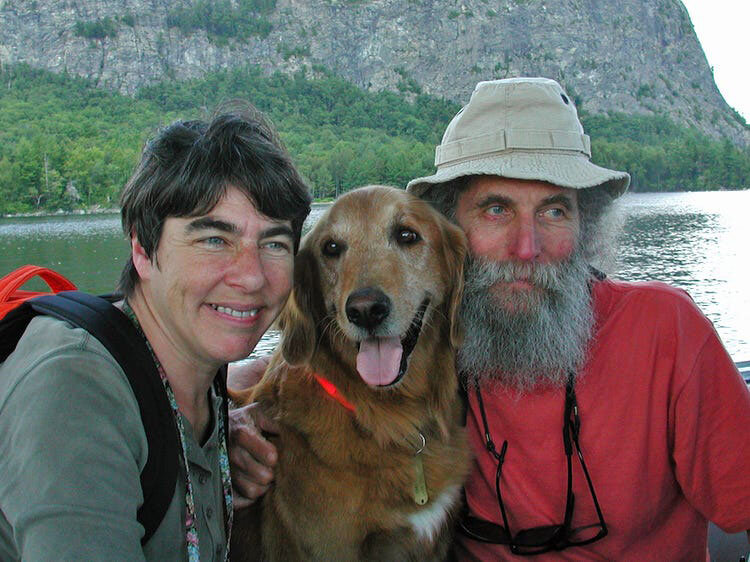Sustainable Spotlight: Burt’s Bees Follows in the Environmentally Conscious Footsteps of its Inspiring Founders
Burt’s Bees Founders Burt Shavitz and Roxanne Quimby
Burt’s Bees, the brand that many of us know and love --especially for their famous beeswax lip balms, is a unique company that has valued nature and the ecosystem from its very beginning. The brand’s fascinating story starts in the 1980s when its founders Burt Shavitz and Roxanne Quimby moved to Maine. Burt, a photojournalist from Manhattan and Roxanne, a San Francisco artist, each had decided to leave the hustle bustle of the city for a more peaceful life in the wilderness of the beautiful state.
“Burt settled into a new life as the local ‘bee man’ after finding a stray beehive and learning how to eke out a living selling honey. One day, Burt pulled over for a hitchhiking Roxanne in his schoolbus-yellow pickup truck, and the two hit it off,” Burt’s Bees shares on their website. The two turned beeswax into candles and lip balm which of course became one of their biggest hits.
“Roxanne used to say that since we take from nature, we must respect and preserve it,” Burts Bees shares. The two founders lived simple, low-impact and environmentally conscious lifestyles. The brand still follows its founders footsteps with a commitment to sustainability and nature-based ingredients.
Cool Facts about the Brand’s Founders:
Roxanne Quimby
After selling her stake in Burt’s Bees, Quimby launched a philanthropic foundation, gave $90 million to charities, and bought over 87,000 acres of pristine Maine woodland that she then donated to the National Park Service.
Burt Shavitz
Burt Shavitz loved the simple life and being surrounded by nature. He converted a 300-square-foot turkey coop into a cozy cabin home. After his death, Burt’s Bees moved the tiny cabin to its Durham headquarters where it can be viewed by visitors.
Signature Product:
The original Beeswax Lip Balm.
What Burt’s Bees Is Currently Doing To Continue the Sustainable Legacy of Its Founders:
Burt’s Bees formulas average 99.6% natural origin, packaging uses 50% recycled materials on average, and it is all recyclable curbside or through TerraCycle. The brand also maintains landfill-free operations and provides $4.1 million in grants to protect biodiversity and connect people to nature. The company has also transitioned to 100% renewable electricity.
Available starting this month, the new Truly Glowing Gel Cleanser will come in a reusable glass bottle with waste-free delivery and return.
What You Should Know About The Brand’s Supply Chain:
Burt's Bees will accelerate efforts to improve sourcing practices and uplift communities who produce their most valued ingredients—such as beeswax and shea butter. They have already impacted over 20,000 livelihoods through a combination of Responsible Sourcing Assessments, third-party audits, and their Global Supply Chain Investment Program. By 2025, they will more than double their efforts—impacting 50,000 livelihoods.
Burt's Bees has visited 115 sites in 25 countries to trace and monitor raw materials—including almost all wax (96%) and butter (97%) sources.
"Our focus has long been centered on the wellbeing of people and the natural world. The challenges of the pandemic have only heightened the importance of protecting nature as a resource, for the health of people and all life on Earth,'' shares Paula Alexander, Burt's Bees Senior Director of Sustainability. "That's why we've chosen to focus on systemic changes across our supply chain while working toward a circular economy—to enable a more connected and stable relationship between people and nature."
What Burt’s Bees Plans to Do by 2025 to Improve Its Eco-Friendly Practices:
Burt's Bees has committed to several large-scale initiatives to reach “Net Zero Plastic to Nature” by 2025, focusing first on changes within its own value chain. These changes include cutting use of virgin packaging materials (plastic and fiber) by 33% (and, by 2030, 50%) and striving toward 100% recyclable, reusable or compostable packaging for all products.
Rescue Lip Balm is packaged in a new hybrid tube featuring bioresin from upcycled potatoes and post-consumer recycled content.
Burt's Bees is also launching its first waste-free product in partnership with Loop. The new Truly Glowing Gel Cleanser will come in a reusable glass bottle with waste-free delivery and return. This joins recently launched Rescue Lip Balm, packaged in a new hybrid tube featuring bioresin from upcycled potatoes and post-consumer recycled content.
To improve recycling rates outside of its value chain, Burt's Bees is joining forces with The Recycling Partnership to fund infrastructure improvements in U.S. municipal recycling systems. In addition, Burt's Bees will invest in plastic waste collection and recycling credits that would lead to recovery and recycling of at least as much plastic as their own plastic footprint.
[Images courtesy of Burt’s Bees]
Lizzy Sherman is an award-winning digital content writer/editor. She has been a featured guest speaker at Cal State University Northridge, Digital LA and The National Association of Audience Marketing Professionals. When she's not writing, Lizzy enjoys yoga and playing guitar. Follow her on Instagram: @zillizy




